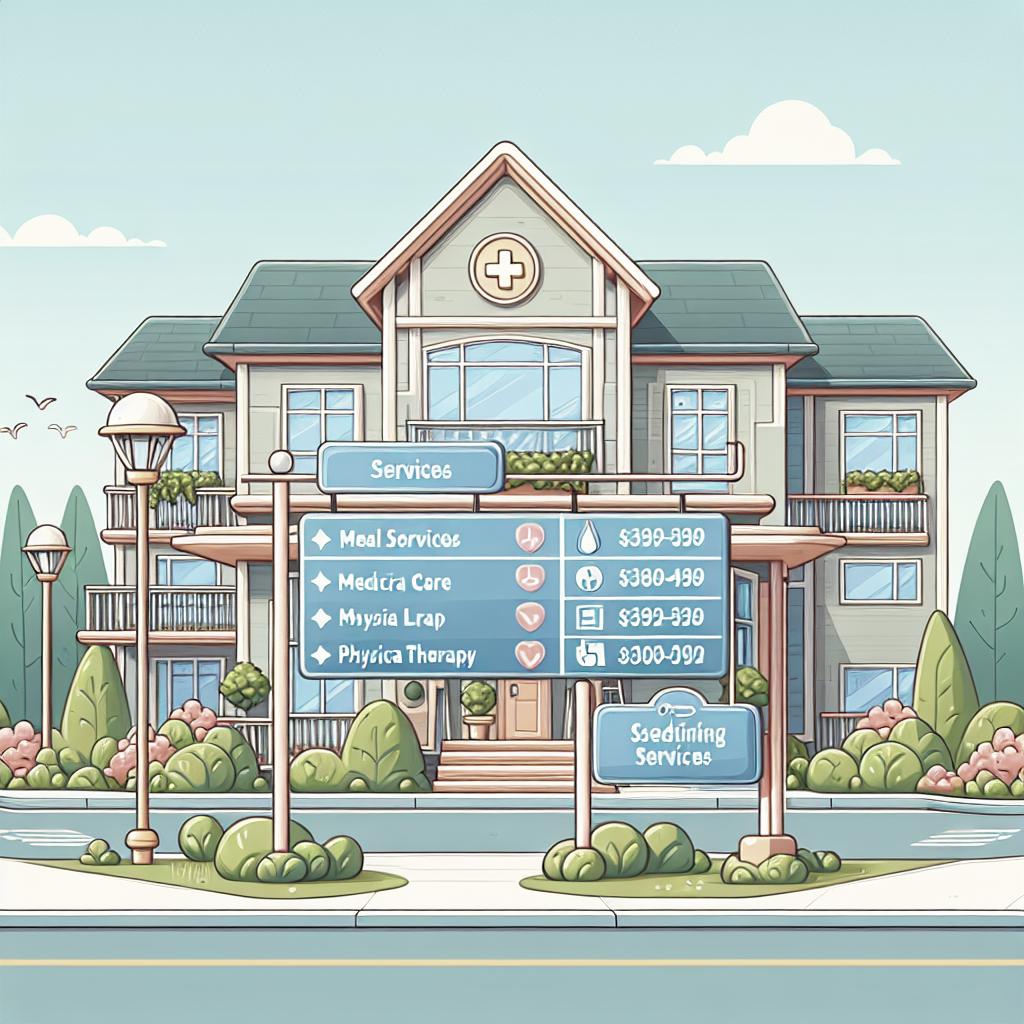<>
Changes in health, mobility, or cognitive abilities often necessitate a move to assisted living. While such transitions come with emotional and lifestyle adjustments, financial aspects hold equal importance. This blog post delves into the costs associated with assisted living facilities. We will cover the average costs, factors that influence these costs, and compare them to other living arrangements like nursing homes and in-home care. Additionally, we’ll provide insights on how to pay for assisted living and discuss why the investment is often worthwhile.
An Overview of Assisted Living Costs and Fees
Assisted living facilities offer a blend of housing, healthcare, and personal care services to those who need assistance with daily activities but do not require intensive medical care. Residents typically receive help with tasks such as bathing, dressing, and medication management. The cost structure for assisted living can vary widely, and it’s crucial to understand what you’re paying for and why.
Comprehensive financial planning is vital when considering assisted living. Costs can be influenced by numerous factors, from the level of care needed to the amenities offered. Residents or their families often encounter a mixture of monthly fees and potential one-time charges, making it essential to scrutinize any agreement closely.
How Much Does Assisted Living Cost?
The average cost of assisted living in the United States hovers around $4,300 per month, according to various industry surveys. However, this figure can be misleading if taken at face value. Monthly rates can range from as low as $2,500 in some regions to more than $6,000 in others, influenced heavily by the type and quality of care provided, geographical location, and additional services.
It’s important to note that these costs generally cover a baseline of services, including meals, housekeeping, and basic personal care. Extra charges can apply for specialized care such as memory assistance, physical therapy, or transportation services. Thus, residents and their families should budget for potential additional expenses over the base rate.
Factors that Impact Assisted Living Costs
Level of Care
The level of care a resident requires significantly influences the total cost of assisted living. Facilities often charge tiered rates based on the intensity and frequency of services needed. For instance, a resident who needs occasional assistance with daily activities will incur lower costs than someone requiring 24/7 care or specialized medical services.
Assessments are usually performed before admission to determine the level of care required. This evaluation can help families estimate initial costs but keep in mind that needs can change over time, potentially leading to increased fees.
Geographical Location
Geographical location is another crucial factor. Assisted living facilities in urban areas or states with higher living costs tend to charge more. For example, facilities in California or New York are generally more expensive than those in the Midwest or South.
This geographical disparity is linked to various factors including real estate costs, local wage standards, and availability of healthcare services. Those looking to optimize costs might consider regional options, keeping in mind the potential trade-offs in services and amenities.
Size of Living Area
The size and type of living area within the facility can also affect costs. Private rooms or larger apartments come with higher price tags compared to shared rooms or smaller living spaces. Assisted living communities offer various accommodation options tailored to resident preferences and budgets.
Facilities might charge more for units with scenic views, private balconies, or kitchenettes. When evaluating different options, consider what living space features are essential versus those that are nice-to-have.
Amenities
The range and quality of amenities can significantly impact the costs of assisted living. Facilities with resort-style amenities like swimming pools, spas, advanced fitness centers, and gourmet dining typically charge more. Additionally, regular activities, outings, and transportation services might come with extra fees.
However, high-quality amenities can enhance the living experience and contribute to overall well-being. Families should weigh these benefits against the additional costs to ensure the chosen facility aligns with their budget and care expectations.
Do Any Assisted Living Communities Charge a Flat Fee?
Some assisted living communities employ a flat-fee structure, offering a more predictable monthly expense. These all-inclusive plans generally cover basic care, meals, housekeeping, and access to specific amenities. This can simplify budgeting for families and residents.
However, flat fees might not cover all potential services, particularly specialized care needs that arise over time. Thoroughly reviewing what is included in the flat fee and what services might incur additional charges is crucial for transparent financial planning.
Assisted Living Costs vs. Nursing Homes, Home Care and More
Assisted Living
Assisted living serves as a middle ground between independent living and more intensive nursing care. As mentioned, the average costs hover around $4,300 per month but can vary based on several factors. This cost covers room, board, personal care services, and basic health services.
While seemingly expensive, assisted living costs generally offer a cost-effective solution when compared to 24-hour in-home care or nursing homes. It also provides a level of community and engagement that is vital for mental and emotional health.
Nursing Homes
Nursing homes are designed for individuals requiring a higher level of medical care and close monitoring. The costs for nursing homes are substantially higher, with an average monthly expense of around $7,750. These facilities are staffed with registered nurses and healthcare professionals to handle severe medical conditions.
Given the specialized care provided, many elderly or disabled adults opt for nursing homes despite the higher costs. Families need to weigh the necessity of specialized medical care against the financial impact.
In-Home Care
In-home care allows seniors to remain in familiar surroundings while receiving needed assistance. Costs for in-home care vary widely based on the level of care required, often ranging from $20 to $40 per hour. A full-time caregiver can cost upwards of $4,000 to $8,000 per month.
While in-home care can be cost-effective for those requiring minimal assistance, the costs can quickly escalate for those needing round-the-clock care. Additionally, the home may need modifications to ensure safety, further increasing the expense.
Cost Structure and Hidden Fees
Assisted living facilities often present an array of cost structures, ranging from tiered pricing based on care levels to all-inclusive fees. Residents might also encounter hidden fees, such as security deposits, move-in fees, and charges for additional services not covered in the basic plan.
Understanding the entire range of costs involved is essential. Families should diligently read contracts, ask pointed questions about potential additional fees, and plan for future expenses to ensure financial viability throughout the resident’s stay.
How to Pay for Assisted Living
Financing assisted living can be a significant concern. Various funding sources can help alleviate these costs, including personal savings, pensions, and investments. Some families also opt to sell their homes to fund such care needs.
Insurance products like long-term care insurance (LTCI) can also help cover some of the expenses. Additionally, Veterans benefits or Medicaid might offer financial assistance for eligible individuals. Knowing all available funding options can significantly ease the financial burden.
The Value of Assisted Living
Opting for assisted living offers more than just basic care; it provides an enriched environment equipped to handle ongoing health and social needs. These facilities organize regular activities, social gatherings, and provide opportunities for engagement that can significantly enhance the quality of life.
This rich social network, combined with professional care, helps residents maintain their independence longer. The peace of mind that comes from knowing a loved one is in a safe, supportive environment is invaluable, often justifying the financial outlay.
Where You Live Matters
The quality and cost of assisted living facilities can vary dramatically depending on the geographical area. Urban centers with higher living costs generally offer more expensive options. Conversely, smaller towns or rural areas might offer more affordable yet less luxurious facilities.
Families should consider both costs and quality when making a decision. Visiting multiple facilities, reading reviews, and talking to current residents or their families can provide a clearer picture of what to expect and aid in making an informed choice.
By Nancy Swanger, PhD, M.Ed
Thank you!
How can we improve?
Thank you!
| Section | Summary |
|---|---|
| An Overview of Assisted Living Costs and Fees | Explains the general cost structure of assisted living, including monthly fees and one-time charges. |
| How Much Does Assisted Living Cost? | Discusses the average monthly cost, highlighting the variance based on care needs and location. |
| Factors that Impact Assisted Living Costs | Details how the level of care, location, size of living area, amenities, and the fee structure affect costs. |
| Assisted Living Costs vs. Nursing Homes, Home Care and More | Compares the cost of assisted living to nursing homes and in-home care and explores hidden fees in detail. |
| How to Pay for Assisted Living | Discusses various financial sources for covering assisted living costs, including personal savings, long-term care insurance, and veterans benefits. |
| The Value of Assisted Living | Highlights the social and medical benefits of assisted living and the importance of choosing the right location. |


